- Elizabeth Larson
- Posted On
President signs Tribal Law and Order Act; local tribal law enforcement agencies weigh in

- Lake County News Reports
- Posted On
Green Jobs Corps and NCCC work toward energy efficiency, stronger workforce
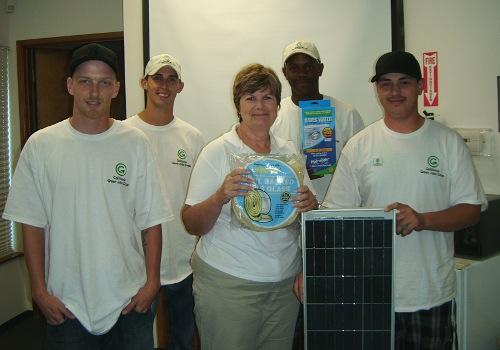
- Elizabeth Larson
- Posted On
Community warned of fundraising scam
Mike Silva, president of the Lake County Correctional Officers Association, said Friday that he and other members of his group have received reports that the association's name is being used in connection to a scam.
Silva said a male subject reported to be based in Hidden Valley Lake was approaching people and asking for funds in connection with a golf shootout that he claimed was being held by the association and by Twin Pine Casino.
“We are not part of that and it is a scam at this point,” Silva said.
Belinda Young of Twin Pine Casino's marketing department also confirmed to Lake County News on Friday that the casino isn't involved in such a fundraiser.
Silva said the group is very concerned about protecting community members from being scammed.
He said the correctional officers association is working on a fundraiser magic show for early next year, which will benefit local nonprofits and other causes. Anyone interested in that legitimate fundraiser can call 800-370-8117.
E-mail Elizabeth Larson at This email address is being protected from spambots. You need JavaScript enabled to view it. . Follow Lake County News on Twitter at http://twitter.com/LakeCoNews and on Facebook at http://www.facebook.com/pages/Lake-County-News/143156775604?ref=mf .
- Elizabeth Larson
- Posted On
Division of Ratepayer Advocates, Cal Water reach proposed rate case settlement
The 600-page proposed settlement document, which was filed June 28, is for the 2009 general rate case. It still must be approved by the California Public Utilities Commission, which is expected to make a final decision by the end of the year in time for the agreement to become effective on Jan. 1, 2011, the company and the DRA reported.
Administrative Law Judge Jeffrey O'Donnell, who traveled to Lucerne in March to host a public meeting on the rate hike, is now writing a proposed decision, said Patrick Hoglund, the DRA's lead on the case. The DRA is a division of the CPUC.
Last week O'Donnell's ruling scheduling briefs and issues yet to be addressed was posted, with the judge giving the company, the DRA and the intervenors August and September deadlines for filing briefs that he will consider in his final decision.
Cal Water originally requested statewide rate increases for 2011 of 16.75 percent, totaling $70.6 million for its 460,000 customers across its 24 California districts, as Lake County News has reported. The company also requested $24.7 million, or 5.04 percent, in 2012 and $24.7 million, or 4.79-percent, in 2013.
The terms of the settlement recommend $34.4 million – or about a 7.1-percent average increase statewide – according to Hoglund.
Cal Water reported that the settlement also included $7 million of rate relief once certain capital projects are completed.
For Lucerne, where the settlement notes that Cal Water has 1,279 customers, the company wanted rate increases of 54.9 percent in 2011, 7 percent in 2012 and 6.6 percent in 2013.
Hoglund said the DRA originally had proposed a 30.6-percent increase for Lucerne, which ultimately is proposed to see rates climb by 41.6 percent for 2011.
“In these settlement negotiations there is give and take on various positions,” he said.
Darin Duncan, Cal Water's rates manager, gave a very preliminary estimate for Lucerne of a 2-percent increase in 2012 and another 2 percent increase in 2013.
“The good news is it's not 55 percent,” said Craig Bach, president of the Lucerne Community Water Organization, a group that formed in 2005 to combat a 273-percent increase for the Lucerne water system that Cal Water proposed. The final increase in that rate case was about 120 percent.
“Until we own our own water, we're going to be victimized by corporate water,” said Bach, who believes Cal Water ended up getting everything it actually wanted in the proposed settlement.
Duncan said the company thinks the proposed settlement is a fair one, and that the Division of Ratepayer Advocates did a very thorough job in analyzing both expense projections and proposed infrastructure projects.
“If the administrative law judge upholds the settlement, I think we will be able to proceed with some very important water projects to increase the reliability of our water systems,” he said.
“There are many projects that will be deferred to future general rate cases that are important to the long-term health of the water systems,” Duncan said. “However, before agreeing to defer these projects, we involved the local system operators for all of the 24 systems in California to ensure we did not defer a project that was critical to have today.”
He said the company hasn't calculated statewide percentages. Hoglund said increases for 2012 and 2013 would be determined later in a separate attrition filing that incorporates inflation, customer growth and infrastructure projects, as well as any advice letter projects that may be completed by the time that filing is made.
Hoglund said settlement talks between Cal Water and the DRA began in April and continued through most of May, with an extension to file the settlement requested and received from the judge. That's because drafting the document took longer than they had anticipated, Hoglund said.
Due to the CPUC's recent schedule, it's now requiring rate cases to be filed on all districts at once, rather than eight at a time, as has been done in the past, according to Hoglund.
As a result, while past documents would have been about 100 pages or slightly larger, Hoglund said this one is 600 pages.
Hoglund said one of the things that had affected a number of districts in the general rate case was the number of positions that Cal Water wanted to add, totaling 75 throughout the state.
“Our initial recommendation had a very low number,” he said, with the settlement ultimately agreeing to 29.
“Of those 29, 11 are actually positions that were carried over from prior years that had not been filled,” he said.
Duncan said the positions will be located in the general office and in the districts.
Previous rate hikes had covered those unfilled positions. When asked if the company can now collect rate hikes to cover those same 11 positions again, Hoglund replied, “The answer would be yes.”
As of last September, of 96 previously requested employee positions, 23 hadn't been hired, Hoglund said.
He said it's difficult to say where those dollars for unhired employees go. The general rate case requires companies to make a reasonable estimate of costs and revenues required to operate, and the forecast revenues need to cover not just expenses but give the company an opportunity to earn a rate of return.
“It's not a specific, hard and fast plan for the utility,” he said. “They have some operational leeway.”
Hoglund said everything is done on a forecast and estimate basis, so there's an expectation that “it's not going to be exactly right.”
However, if the company is continually forecasting and requesting additional employees but not filling the positions, “That's problematic,” Hoglund said.
The goal is for companies to get better at planning and forecasting, he explained. “For something like hiring employees, we can point out to the company that here are areas of concerns.”
Duncan said the company acknowledges that it had difficulty in the past filling all of its approved positions.
There were a number of reasons for that – from its human resources department not being set up to hire as many people as needed to a wave of retirements and critical background checks, which slowed the process.
“We have now identified all bottlenecks to the hiring process and have outsourced some of the background checks and other hiring requirements that make sense and have made strives to eliminate hurdles,” Duncan said. “I am confident that we will be able to hire the new employees in a timely manner, while ensuring we have the best people working on the water supply for our customers.”
As for what ratepayers can expect next year, “The actual rate design has not yet been done,” said Hoglund, explaining that will part of O'Donnell's proposed decision.
While no party intervened on behalf of Lucerne, Santa Rosa resident Jeffrey Young intervened on behalf of the Marin County community of Dillon Beach, located south of Bodega and west of Tomales. This is his third rate case in nine years.
Cal Water is one of two water companies in the community, covering about 250 homes, Young said. The community has both low income members and those who are extremely affluent, with about 20 percent of the residents living there full-time.
Rates for customers of Cal Water's customers will go up 78 percent if the settlement is approved, less than half the 153 percent the company had sought. Dillon Beach recently had another 33-percent increase, Young said.
While negotiations are still going on regarding a rate support fund, which Young said could help Lucerne's rates, he added, “I am not going to disagree with anything that's in the settlement.”
However, the settlement is still very much in discussion, with some of the communities disputing costs of projects and other items listed in the proposed settlement, according to communications exchanged between the parties.
Back in Lucerne, Bach and other town residents are complaining about water quality. Despite the town having a new multimillion dollar water plant, many people are complaining that the water coming out of their taps has a strong odor they attribute to the summer's algae blooms.
E-mail Elizabeth Larson at This email address is being protected from spambots. You need JavaScript enabled to view it. . Follow Lake County News on Twitter at http://twitter.com/LakeCoNews and on Facebook at http://www.facebook.com/pages/Lake-County-News/143156775604?ref=mf .
- Vicky Parish Smith
- Posted On
Quilt trail: Finca Castelero

KELSEYVILLE, Calif. – Luis and Christie White Castelero have added their Finca Castelero to the Lake County Quilt Trail.
Located at 4050 Loasa Drive, Kelseyville, the beautiful quilt block, entitled “Ohio Star,” has been hung on the northern face of their barn.
The Casteleros are honoring their dear friend, Lynn Morassi, who died of ovarian cancer in 2008 and is greatly missed by family and friends.
Morassi was an excellent seamstress who loved to sew and quilt. “The LCQT project would have thrilled her greatly,” said Christie White Castelero.
The quilt block design, Ohio Star, is stitched into one of the three quilts gifted to Castelero from her own grandmother. The family is very pleased with this lovely reminder of their friend and the family heritage of the design.
“Finca” is a Spanish word that means “small farm.” In this case, the Casteleros have 20 acres planted in Bartlett pears and Syrah grapes, organic vegetables and olives.
Luis Castelero was born in Spain and spent his childhood on his grandfather’s farm.
His lifelong dream was realized when he and Christie purchased the Kelseyville property in 2005.
Their love of food has been enhanced with the creation of their own organic vegetable garden. It provides a wide variety of fresh produce as well as prized special peppers that are typically found in Spain.
The property originally was developed during the 1920s. It was one of the original labor camps in Kelseyville owned by the Dorn family.
Its two bunkhouses were used by seasonal orchard workers for many years. Currently, the buildings are under reconstruction but still are used as sleeping quarters for the many guests who visit as well as the owners.
The camp kitchen is in a separate building under the magnificent older oaks that provide cooling shade and make up the charming setting for outdoor living.
For your own self-guided map of all the quilt blocks in the Lake County Quilt Trail, go the the Kelseyville Pear Festival Web site, www.kelseyvillepearfestival.com, and click on the quilt trail button.
Follow Lake County News on Twitter at http://twitter.com/LakeCoNews and on Facebook at http://www.facebook.com/pages/Lake-County-News/143156775604?ref=mf .
- Lake County News reports
- Posted On
One of state's 'most wanted' contractors in custody after extradition from Oklahoma
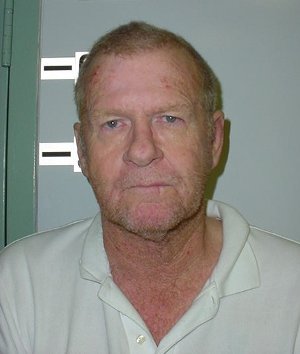
- Kate Lyons
- Posted On
Green expectations in India
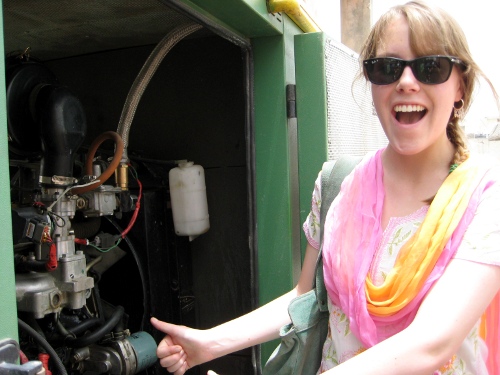
Namaskar! I’m writing this sitting in my apartment in New Delhi, India, almost 10,000 miles (nearly half the circumference of the planet!) away from my hometown of Lower Lake, Calif.
I’m here, working for Tata Teleservices Limited (TTSL) under the Tata International Social Entrepreneurship Scheme, an internship designed to connect college students from partner universities (such as UC Berkeley, where I’m about to enter my junior year) and various Tata group companies all over India.
Tata is a large, multinational conglomerate, with interests in many products that Americans use every day, such as Tetley Tea and Land Rover/Jaguar, and many other goods and services worldwide.
In India, you will see Tata everywhere, from automobiles to satellite television, to food and hotels; the prestigious Taj line of hotels is also a Tata group company.
I was assigned to Tata Teleservices Limited (TTSL), Tata group’s presence in the Indian telecom sector.
Like any other corporate entity, TTSL has environmental issues. Most people (including me) don’t associate cell phones with generating much pollution, but the Indian telecom sector is the second-largest consumer of diesel in the country, just under Indian railroads.
Why so much juice? Well, cell phone towers run on electricity, and with frequent power cuts and unavailable electricity access (especially in rural areas) diesel generators are used to provide back up and full time power.
Providing 400 million subscribers with mobile service requires over 250,000 towers, each using five to 10 liters of diesel per day ... one can imagine the release of carbon!
To offset this massive amount of pollution, TTSL is looking into all sorts of green technology, from solar and wind power to biomass generators.
It was my responsibility as an intern to assess TTSL’s current green initiatives, and to provide recommendations for improvement and new areas of research and investment.
When I first received this assignment, I was surprised and apprehensive. On my application, I had mentioned an interest in the environment and some past volunteer involvement with two local conservation groups, the Lake County Land Trust and the Redbud Audubon Society.
However, at UC Berkeley, I’m a full blown liberal arts and humanities student, majoring in linguistics and Indian languages. How was I qualified to fill the role of a green technology consultant?
My first visit out in the field, on June 22, tested these qualifications.
A group from the Delhi TTSL office including me ventured out to North Delhi to visit some of TTSL’s new “green” cell tower sites. The sites on the tour included a compressed natural gas generator in Model Town, and a fuel cell in Nangloi.
Braving the heat with limited air conditioning, we shuttled from one location to the next, quickly viewing the sleek, shining equipment.
Returning to the office later that afternoon, I proudly showed the rest of the Corporate Sustainability Team some of the photos I’d taken.
“See this?” I asked, smugly gesticulating towards my camera’s display screen. “It’s a fuel cell.”
“Are you sure?” one of my neighbors asked. “This looks an awful lot like a tank of hydrogen to me.”
A Google search revealed what a fuel cell truly looks like. Staring at the image – a small, elegant and expensive-looking machine that resembled a battery – I realized exactly how underqualified I was.
I was nervous before I started this internship, but this gaff made me painfully aware of how green I was in my knowledge of environmentally-friendly technology.
In the following weeks, however, I have managed to learn enough about cutting-edge green technology to offer TTSL some recommendations, and to daydream about environmentally friendly changes I’d like to support both at UC Berkeley and in Lake County.
We have so many resources at our disposal, I’ve realized how easy it is for us to reduce our carbon footprint, and how shameful it is that we haven’t already.
Apart from these green initiatives, I’ve also learned a lot about corporate sustainability – TTSL’s way of doing corporate social responsibility – and how companies can provide ethical, sustainable vocational and economically empowering opportunities for the less fortunate of its community; methods from which both US companies and communities could benefit.
I take off in two weeks, and I leave behind a bustling, frenetic city that I now love. Delhi – and India as a whole – for me is an amazing, inspiring place, and I find it familiar, comfortable and ordinary.
I always think of Rudyard Kipling’s “The Ballad of East and West”:
East is East and West is West and never the twain shall meet,
No one ever remembers the rest of the poem:
But there is neither East nor West, Border, nor Breed, nor Birth,
When two strong men stand face to face,
tho’ they come from the ends of the earth!
India is similar to Lake County in some fundamental ways. The same problems and concerns exist in both places: the same anxiety for the impoverished, the same crusade for public awareness; the same struggle between empathy and apathy. Ten thousand miles away, and we can still learn a lot from one another.
Observing the corporate sustainability work TTSL is engaged in has shown me how I can apply the same mentality and strategy to projects and programs back home, helping to make American corporate sustainability as real as i have seen it to be in India.
Kate Lyons is a 2008 Lower Lake High School graduate, born in St. Helena and raised in Lower Lake, Calif. She currently is a junior at University of California, Berkeley, majoring in linguistics with a minor in global poverty and practice.
Follow Lake County News on Twitter at http://twitter.com/LakeCoNews and on Facebook at http://www.facebook.com/pages/Lake-County-News/143156775604?ref=mf .
- Lake County News reports
- Posted On
Three planets gather in twilight in August
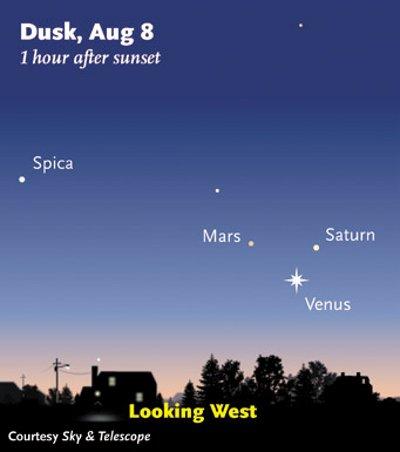
Step outside as evening twilight fades, and from now through the middle of August you’ll find three planets shining low in west – one much brighter than the other two. All you’ll need is a clear sky and an open westward view about an hour after sunset.
“Venus will leap out at you,” said Alan MacRobert, a senior editor of Sky & Telescope magazine. “Saturn and Mars are fainter, so you may need to wait for the sky to darken a bit more before they glimmer into view.”
Venus is the famed “Evening Star,” the brightest celestial object in Earth’s sky after the Sun and Moon.
Saturn and Mars are only about 1 percent as bright. They form a more-or-less horizontal line above Venus, as wide as three or four fingers held together at arm’s length.
Saturn and Mars will spend the week sliding to the right with respect to Venus, creating a planetary triangle that changes shape from day to day.
Although the three planets look close together, they’re not. Venus is currently 6 light-minutes (73 million miles) from Earth, Mars is 17 light-minutes (190 million miles) distant and Saturn is far in the background 85 light-minutes (950 million miles) away.
Three reasons combine to make Venus shine so much brighter than the others. It’s the closest to us, it’s the closest to the Sun so it’s illuminated more intensely, and it’s covered with brilliantly reflective white clouds.
As for Mars and Saturn? They look similar in brightness for reasons that cancel out. Saturn is 35 times larger than Mars, but it’s much farther both from us and from the Sun.
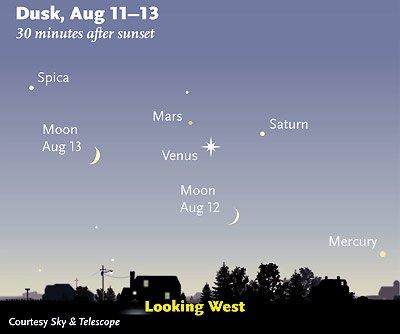
The crescent Moon joins the twilight planet scene on Thursday, Aug. 12, when it’s below Venus, and on Friday, Aug. 13, when it’s left of Venus.
“Don’t miss this chance to do some easy astronomy from your backyard, balcony, or rooftop,” says Sky & Telescope editor in chief Robert Naeye. “It’s a big universe, and planets await!”
For more skywatching information and astronomy news, visit www.SkyandTelescope.com, the essential magazine of astronomy since 1941.
Follow Lake County News on Twitter at http://twitter.com/LakeCoNews and on Facebook at http://www.facebook.com/pages/Lake-County-News/143156775604?ref=mf .
- Lake County News reports
- Posted On
STATE: Governor announces state employee salary transparency Web page
The new Web page will be part of the Reporting Transparency Web site, www.reportingtransparency.ca.gov, which Schwarzenegger launched in March 2009.
Last week at a budget discussion in San Diego Schwarzenegger called for greater transparency and accountability of public employee salaries by government at all levels.
When the Reporting Transparency site was launched last year, Schwarzenegger issued a memorandum to all governor's staff, all agency secretaries and all department directors directing them to make publicly available on the governor's Web site the statement of economic interests, Form 700, and the travel expense claims for the governor's office senior staff and deputies, agency secretaries, agency undersecretaries and department directors.
The site made information regarding statement of economic interests, Form 700 and travel expense claim forms readily available to the public. Now comes the addition of the salary information.
“Californians have the right to know what's happening with their money and how it's being spent,” Schwarzenegger said in a Friday statement. “Public employees and elected officials work for the citizens of this state and the salaries of public employees and elected officials should be easily accessible.”
In addition to Schwarzenegger's Friday announcement, earlier this week State Controller John Chiang reported that the state was implementing new compensation reporting requirements for all California cities and counties, with the information to be posted on the state controller’s Web site, www.sco.ca.gov, starting in November, as Lake County News has reported.
Follow Lake County News on Twitter at http://twitter.com/LakeCoNews and on Facebook at http://www.facebook.com/pages/Lake-County-News/143156775604?ref=mf .
- Lake County News Reports
- Posted On
The Veggie Girl: Blackberries

There are more than 375 species of blackberries, and in the U.S. they’re most prevalent in eastern states and those that border the Pacific. They also grow abundantly in the British Isles and throughout Western Europe, but are known through most of the temperate and tropical world.
Though an ancient fruit, they’ve not been cultivated long within the scope of human history, probably because of their abundance in the wild. It’s theorized that the advent of agriculture made these berries even more prevalent because of the clearing of forests.
As urbanization increased, wild blackberries became less available to city dwellers, thus fueling an effort from the late 1860s forward, especially in the U.S., to find strains of wild blackberries that would do well in the garden.
Cultivated blackberries today are not that much different from their wild ancestors, except for the size of the berry, which is larger. However, when I think of blackberries, the wild brambles along roadsides and creeks that offer picking for all are what come to mind.
I spent many a summer day with friends getting my fill of these sweet berries, with plenty of scratches on my arms from the prickly brambles to show for it. They were the perfect fruit in those days: free and prolific, not to mention the joy of adventurous trekking to find the perfect picking spot.
What I didn’t realize then was just how much nutrition is packed into these little black jewels.
Blackberries are ranked fourth highest among all fruits and vegetables in antioxidant-richness; however, they’re the second highest in actual chemical effectiveness in preventing oxidation in cells.
In addition, this humble berry contains the highest LDL cholesterol inhibitor, and some tests indicate that it can reduce buildup of this undesirable cholesterol.
They’re also a fantastic source of immune-boosting vitamin C, skin-supporting and heart-protecting vitamin E, folate (known as folic acid within the B vitamin complex), manganese and fiber.
Blackberries are rich in salicylate and its leaves and roots are full of tannic acid, both of which are natural analgesics. They were prescribed by the ancient Greeks for gout and by Native Americans to relieve stomach ailments.
The recipe I offer today is a clafouti (pronounced kla-foo-TEE) made with blackberries. Clafouti, a cake with a comforting pudding-like consistency, originated in the Limousin region of central France. There it’s traditionally made with cherries.
When blackberries are not in season, the frozen variety may be used. Or you may wish to substitute other fruit, such as plums, peaches, sliced apples, other berries or the traditional cherry. All fruit should be pitted, and a similarly-flavored brandy may be substituted for the blackberry brandy in this recipe.
If you have a favorite picking spot, now is the time to collect these healthy little gems, as they’re in the height of their season. Enjoy the hunt, and be sure to wear long sleeves and pants to avoid those nasty scratches!
Blackberry clafouti
Butter for the pan (approximately a tablespoon)
4 eggs
1 cup granulated sugar, divided
1 tablespoon blackberry brandy (if unavailable, unflavored brandy may be substituted)
1 teaspoon lemon zest (the grated rind of lemon without the white pith)
1 tablespoon freshly-squeezed lemon juice
1 ¼ cups all-purpose flour
1 ½ cups milk
3 cups fresh blackberries (or more, up to four cups)
Powdered sugar for dusting
Preheat the oven to 375 degrees F. Butter an oven-proof dish, deep dish pie plate or cast-iron pan with a depth of at least 1 ½ inches.
Place eggs, 3/4 cup sugar, brandy, lemon zest, lemon juice, flour and milk in a blender and puree until smooth, or beat vigorously with a whisk.
In a mixing bowl, toss the blackberries with the remaining ¼ cup sugar. Place three-quarters of the blackberries and their juices in the bottom of the baking dish. Pour the batter over the fruit, and arrange the remaining berries on top.
Bake for 40 to 45 minutes or until the top is brown and a knife inserted into the middle of the dish comes out clean. Remove from the oven and cool for five minutes before serving. The cake will sink slightly.
Sprinkle with powdered sugar over the top with a sieve. Serve the blackberry clafouti warm. Top with whipped cream, if desired.
Esther Oertel, the "Veggie Girl," is a personal chef and culinary coach and is passionate about local produce. Oertel owns The SageCoach Personal Chef Service and teaches culinary classes at Chic Le Chef in Hidden Valley Lake. She welcomes your questions and comments; e-mail her at This email address is being protected from spambots. You need JavaScript enabled to view it..
Follow Lake County News on Twitter at http://twitter.com/LakeCoNews and on Facebook at http://www.facebook.com/pages/Lake-County-News/143156775604?ref=mf .
- Elizabeth Larson
- Posted On
USDA Rural Development visits Lakeport clinic to see stimulus funds at work
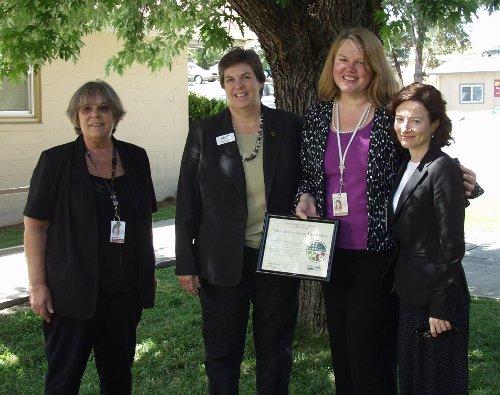
- Elizabeth Larson
- Posted On
Federal legislation restores geothermal royalties to counties
Last month the House of Representatives passed the Supplemental Appropriations Act of 2010, HR 4899, which President Barack Obama signed on July 29.
The legislation amends for the 2010 fiscal year provisions of the Department of the Interior Appropriations Bill, HR 2996, passed last fall, which deemed that there would be no geothermal revenues for counties in the current fiscal year, as Lake County News has reported.
It's an important development for Lake County, which – thanks to the Energy Policy Act of 2005 – has received several million dollars from leases and royalties based on the county's geothermal development.
“The geothermal royalties are a very important revenue source for Lake County,” said County Administrative Officer Kelly Cox, who led the charge locally to restore the funds after it was discovered last fall that they had been taken away.
Congressman Mike Thompson, who has worked since last year to restore the funding, told Lake County News in a Tuesday interview that the funding issue could have been fixed earlier had it been discovered, but he noted, “It wasn't found out until late in the game.”
He added, “It was a very, very sneaky move on somebody's part.”
Thompson, a member of the House Ways and Means Committee, said he put restoration of the funding in four bills which passed the House of Representatives but which didn't make it through the Senate.
He also worked with Sen. Harry Reid of Nevada on the issue, with Reid putting it in two previous Senate bills, Thompson said.
“I have literally worked on this every day since it was determined there was a problem,” Thompson said.
Cox said the payments are made in monthly increments.
For the 2007 and 2008 fiscal years, Lake County received a total of $3.6 million, the most of any county in the United States, followed by Sonoma County, as Lake County News has reported.
According to Department of the Interior statistics, Lake County received $824,269.63 for 2009.
Those funds have been used locally for projects such as the Mt. Konocti land purchase, the county reported.
The Energy Policy Act gave geothermal energy-producing states 50 percent of geothermal sales, bonuses, rentals and royalties, with 25 percent to the counties where the resources are located, according to the legislation.
More than 30 counties in six states – California, Nevada, Idaho, Utah, Oregon and New Mexico – have received benefit from the legislation, according to Department of the Interior records.
Despite the funds being taken away last year, the federal government made a mistake and sent out checks to counties anyway.
Lake County received a payment for just over $256,000, with Cox receiving a letter from a Department of the Interior official in May asking for the funds back, as Lake County News has reported.
The new legislation is retroactive so the county won't have to repay those mistakenly issued funds, said Cox.
While the problem is fixed for now, Cox is concerned about the future, noting that it's his understanding that the Obama administration is proposing to take the funds away again in 2011.
“So we'll need to continue working with Congress to make sure that proposal isn't approved,” he said.
E-mail Elizabeth Larson at This email address is being protected from spambots. You need JavaScript enabled to view it. . Follow Lake County News on Twitter at http://twitter.com/LakeCoNews and on Facebook at http://www.facebook.com/pages/Lake-County-News/143156775604?ref=mf .
LCNews
Responsible local journalism on the shores of Clear Lake.
Memberships:
 |
 |
 |
 |
 |
 |

